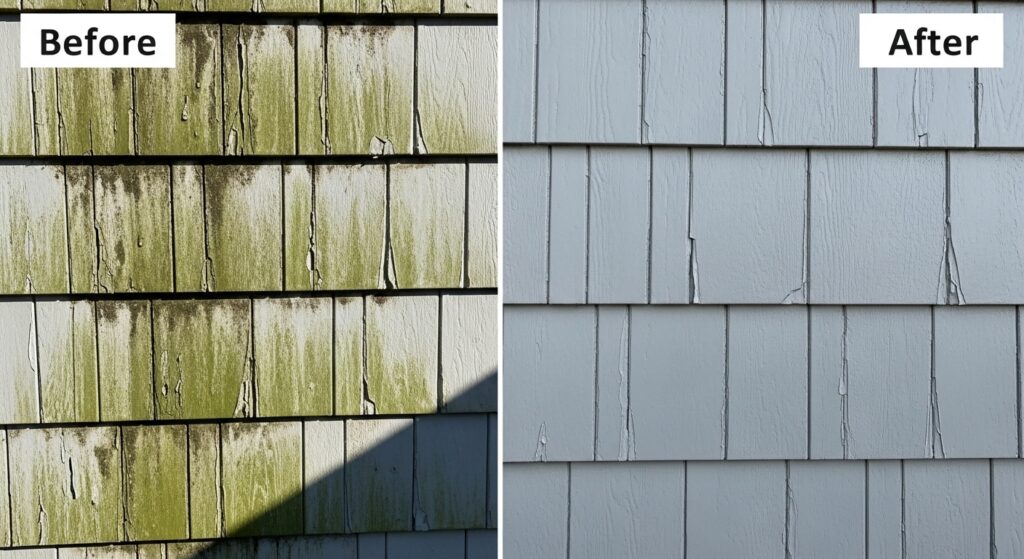Your home’s siding plays a crucial role in protecting it from the elements, providing insulation, and enhancing its curb appeal. With proper care and maintenance, your siding can last for decades, saving you money on repairs and replacements. Whether you have vinyl, wood, or fiber cement siding, regular siding installation & maintenance can significantly extend its lifespan. In this guide, we’ll explore practical steps to help you maintain your siding and keep it in top condition for years to come.
1. Regularly Clean Your Siding
One of the simplest and most effective ways to maintain your siding is to clean it regularly. Dirt, dust, algae, mold, and mildew can build up over time, compromising the appearance and function of your siding.
- Vinyl Siding: For vinyl siding installation, cleaning is especially important to avoid stains and discoloration. Use a soft cloth or sponge with a mixture of mild detergent and water to scrub the surface. For tougher stains, a power washer set to a low pressure can be used.
- Wood Siding: Wood siding requires a more gentle approach. Use a soft brush to remove debris and wash the surface with a solution of mild soap and water. Be sure to treat any areas with mold or mildew promptly to prevent decay.
- Fiber Cement Siding: Fiber cement is durable and low-maintenance but can still accumulate dirt and debris. Regular washing with a hose or pressure washer is often enough to keep it looking new.
Regular cleaning helps prevent the buildup of dirt and grime, which can cause damage over time. It’s also a great opportunity to inspect your siding for early signs of wear and tear, which could lead to the need for siding repair down the line.
2. Inspect for Damage Regularly
Even if your siding looks good, it’s essential to conduct regular inspections to ensure it remains in top condition. Look for signs of damage, such as cracks, dents, loose panels, or warping.
- Vinyl Siding: Vinyl siding installation is a popular choice because of its durability, but it can crack or warp under extreme conditions. Inspect the siding regularly for any visible cracks or holes that could allow moisture to seep in.
- Wood Siding: Wood is more susceptible to rot and insect infestations. Check for soft spots, holes, or discoloration. Look for signs of mold or mildew, and treat them promptly to prevent further damage.
- Fiber Cement Siding: While fiber cement is more resistant to weathering, it can still be damaged by impacts or extreme weather conditions. Inspect for any chips, cracks, or separation between the panels.
If you notice any issues during your inspection, it’s crucial to address them promptly. Delaying repairs can lead to more significant damage, which may require siding repair or even full replacement.
3. Caulk and Seal Gaps
Over time, the caulking and seals around your windows, doors, and joints can deteriorate. This can allow moisture to seep behind your siding, potentially causing rotting, mold growth, or other types of damage.
- Caulk Maintenance: Regularly check the caulking around windows, doors, and trim. If you notice that the caulk is cracked, peeling, or missing, it’s time to replace it. Apply a high-quality caulk designed for exterior use to seal gaps and prevent water infiltration.
- Seal Around Panels: Ensure that the seams between siding panels are properly sealed. Gaps or cracks in these seams can lead to water damage and mold growth over time.
Sealing your siding properly not only keeps it looking good but also helps prevent damage caused by water and weather.
4. Maintain Proper Ventilation
Proper ventilation is key to extending the lifespan of your siding, especially in areas prone to moisture buildup, such as basements or attics. Poor ventilation can lead to condensation, mold growth, and ultimately, deterioration of your siding.
- Check Ventilation Systems: Ensure that your attic or crawl spaces are well-ventilated. This will help prevent excess moisture buildup that could compromise your siding.
- Avoid Blocked Vents: Regularly inspect vents to ensure they aren’t blocked by debris or insulation. Blocked vents can lead to moisture retention, which can damage the siding and encourage mold growth.
By ensuring proper airflow around your home, you can reduce the risk of moisture buildup and extend the life of your siding.
5. Repaint or Reseal Your Siding as Needed
For siding materials like wood or fiber cement, painting or resealing is an essential part of maintenance. This not only enhances the look of your home but also protects the siding from the elements.
- Wood Siding: If your home has wood siding, it’s important to repaint or reseal it every 3-5 years, depending on the climate. Repainting prevents the wood from drying out, cracking, or peeling, while sealing it helps protect it from moisture damage.
- Fiber Cement Siding: Fiber cement siding is usually pre-painted, but over time, it may need a fresh coat of paint to maintain its protective finish. Repainting fiber cement siding can also enhance the curb appeal of your home.
- Vinyl Siding: Vinyl siding doesn’t require painting, but if it starts to fade or discolor, you can clean it thoroughly or replace damaged panels.
Properly maintaining your paint or sealant will help your siding last longer and keep it looking fresh. If your siding shows signs of wear, it may be time for a siding installation & maintenance service to ensure your home is properly protected.
6. Trim Back Vegetation
Overgrown trees, shrubs, or vines can cause significant damage to your siding if left unchecked. Vegetation can trap moisture against the siding, leading to rot or the growth of mold and mildew. Additionally, tree branches that touch your siding can scratch or dent it.
- Trim Vines and Branches: Regularly trim any vines, shrubs, or branches that come into contact with your siding. Keep vegetation at least a few inches away from the exterior of your home to allow air to circulate and prevent moisture buildup.
- Inspect for Pests: Overgrown plants can also attract pests like termites or carpenter ants, which can cause further damage to wood siding. If you notice signs of infestation, contact a professional for siding repair.
By keeping plants trimmed and away from your siding, you reduce the risk of damage and ensure your siding remains in excellent condition.
Contact Us for Expert Siding Maintenance
Regular siding installation & maintenance is essential for keeping your home protected from the elements and extending the lifespan of your siding. If your siding is in need of professional care or if you notice signs of damage, Prime Home Remod is here to help. Our team of experts provides comprehensive siding repair and maintenance services to ensure your siding stays in top condition for years.
Get in touch with us today to schedule a consultation or to learn more about how we can help you maintain your siding and protect your home.
Conclusion
Proper maintenance is essential for extending the lifespan of your siding and keeping your home looking its best. By following these simple steps—regular cleaning, inspecting for damage, sealing gaps, maintaining ventilation, and repainting as needed—you can protect your siding from the elements and avoid costly repairs. Whether you need a siding installation, siding installation & maintenance, or siding repair, Prime Home Remod is ready to provide you with expert services that will ensure your siding lasts for many years to come.




